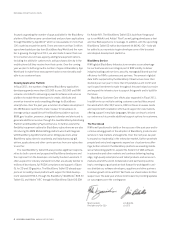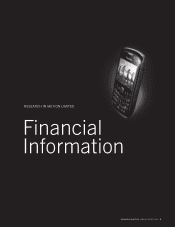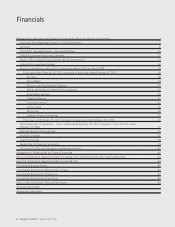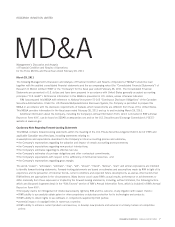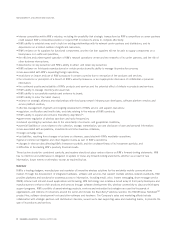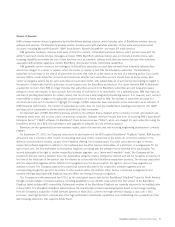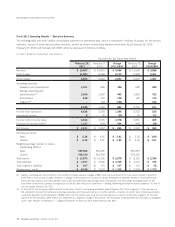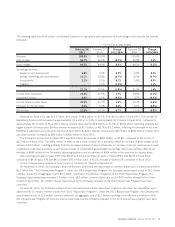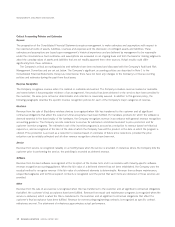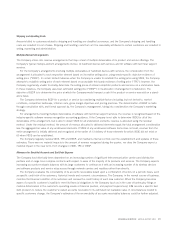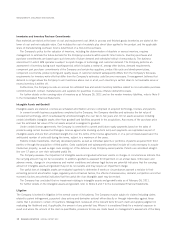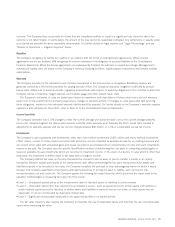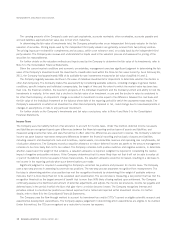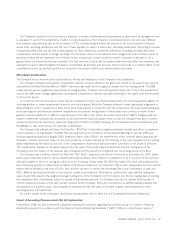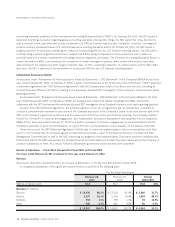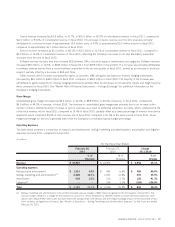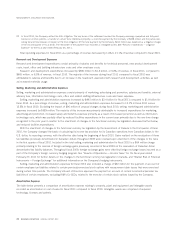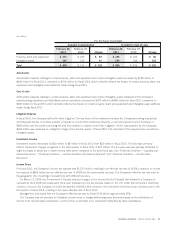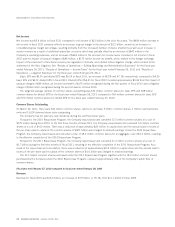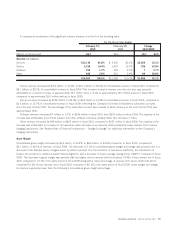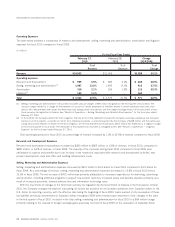Blackberry 2011 Annual Report Download - page 27
Download and view the complete annual report
Please find page 27 of the 2011 Blackberry annual report below. You can navigate through the pages in the report by either clicking on the pages listed below, or by using the keyword search tool below to find specific information within the annual report.Inventories and Inventory Purchase Commitments
Raw materials are stated at the lower of cost and replacement cost. Work in process and finished goods inventories are stated at the
lower of cost and net realizable value. Cost includes the cost of materials plus direct labor applied to the product and the applicable
share of manufacturing overhead. Cost is determined on a first-in-first-out basis.
The Company’s policy for the valuation of inventory, including the determination of obsolete or excess inventory, requires
management to estimate the future demand for the Company’s products within specific time horizons. Inventory purchases and
purchase commitments are based upon such forecasts of future demand and scheduled rollout of new products. The business
environment in which RIM operates is subject to rapid changes in technology and customer demand. The Company performs an
assessment of inventory during each reporting period, which includes a review of, among other factors, demand requirements,
component part purchase commitments of the Company and certain key suppliers, product life cycle and development plans,
component cost trends, product pricing and quality issues. If customer demand subsequently differs from the Company’s forecasts,
requirements for inventory write-offs that differ from the Company’s estimates could become necessary. If management believes that
demand no longer allows the Company to sell inventories above cost or at all, such inventory is written down to net realizable value or
excess inventory is written off.
Furthermore, the Company records an accrual for estimated fees and vendor inventory liabilities related to non-cancelable purchase
commitments with contract manufacturers and suppliers for quantities in excess of future demand forecasts.
For further details on the carrying value of inventory as at February 26, 2011 and on the vendor inventory liabilities, refer to Note 6
to the Consolidated Financial Statements.
Intangible Assets and Goodwill
Intangible assets are stated at cost less accumulated amortization and are comprised of acquired technology, licenses and patents.
In connection with business acquisitions completed by the Company, the Company identifies and estimates the fair value of
(i) acquired technology, which is subsequently amortized straight-line over two to five years and, (ii) net assets acquired, including
certain identifiable intangible assets other than goodwill and liabilities assumed in the acquisitions. Any excess of the purchase price
over the estimated fair value of the net assets acquired is assigned to goodwill.
Under certain license agreements, the Company is committed to current and future royalty payments based on the sales of
products using certain licensed technologies. License agreements involving up-front lump sum payments are capitalized as part of
intangible assets and are then amortized straight-line over the terms of the license agreements or on a per unit basis based upon the
anticipated number of units sold during the terms, subject to a maximum of five years.
Patents include trademarks, internally developed patents, as well as individual patents or portfolios of patents acquired from third
parties or through the acquisition of third parties. Costs capitalized and subsequently amortized include all costs necessary to acquire
intellectual property, as well as legal costs arising out of the defense of any Company-owned patents. Patents are amortized straight-
line over 17 years or over their estimated useful life.
The Company assesses the impairment of intangible assets and goodwill whenever events or changes in circumstances indicate that
the carrying amount may not be recoverable. In addition, goodwill is assessed for impairment on an annual basis. Unforeseen and
adverse events, changes in circumstances and market conditions and adverse legal factors are potential indicators that the carrying
amount of intangible assets and goodwill may not be recoverable and may require an impairment charge.
The useful lives of intangible assets are evaluated quarterly to determine if events or circumstances warrant a revision to their
remaining period of amortization. Legal, regulatory and contractual factors, the effects of obsolescence, demand, competition and other
economic factors are potential indicators that the useful life of an intangible asset may be revised.
The Company has concluded that no impairment relating to intangible assets and goodwill exists as of February 26, 2011.
For further details on the intangible assets and goodwill, refer to Notes 6 and 7 to the Consolidated Financial Statements.
Litigation
The Company is involved in litigation in the normal course of its business. The Company may be subject to claims (including claims
related to patent infringement, purported class actions and derivative actions) either directly or through indemnities against these
claims that it provides to certain of it partners. Management reviews all of the relevant facts for each claim and applies judgment in
evaluating the likelihood and, if applicable, the amount of any potential loss. Where it is considered likely for a material exposure to
result and where the amount of the claim is quantifiable, provisions for loss are made based on management’s assessment of the likely
14 RESEARCH IN MOTION ANNUAL REPORT 2011
MANAGEMENT’S DISCUSSION AND ANALYSIS


